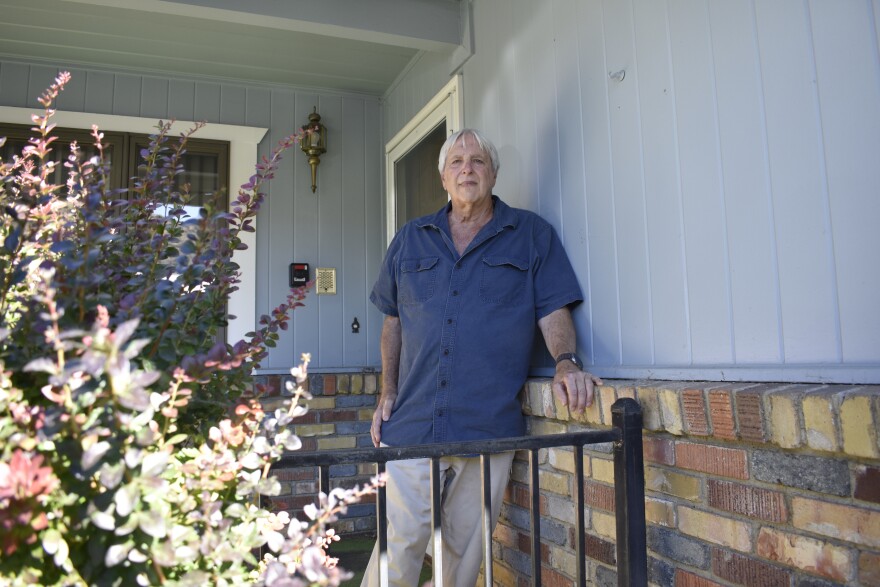In the wee hours after the Fourth of July, Carson City resident Stephen Weil was hosing down his roof and xeriscaped front lawn. Flames engulfed the hillside near his home.
“I’m looking straight up at the flag and the burned area right above it, and there’s one house and a pioneer graveyard between me and C Hill,” Weil said while stepping on the turf in front of his home.
That night, his house was spared.
Like Weil, homeowners throughout the West are facing another type of threat — the loss of their homeowners’ insurance because of wildfires.
As he sat among stacks of letters and spreadsheets in his dining room, Weil read from the non-renewal letter from Farmers Insurance he received on January 29.
“I’m going to get right to the bad news: The company conducted a reevaluation of your property. Due to the location of your property, the company is no longer willing to continue to insure your home the same way,” Weil said.
Weil’s home is located in a high-risk area and is more than 30 years old. For him, that meant two strikes and you’re out. Weil spent 80 hours during the two months he had to find new coverage before his policy was canceled. Two of the larger insurers he contacted weren’t issuing new policies in Nevada at all.
Weil, who lives off Social Security and his 401(k), said becoming uninsured was never an option.
“That would be extremely nerve-racking, knowing that you couldn’t replace the home is a very disturbing thought. I’ll make it as fireproof as I can, but if worst comes to worst, you’d have to dip into savings,” Weil said.
At the last minute, Weil was able to find a new policy to avoid a coverage gap, but his experience isn’t unique.
Nearly 1,500 policies have been canceled or not renewed due to wildfire risk in the state. According to the 2025 Nevada Insurance Market Report, natural disasters have led to increased destruction of homes nationwide, prompting insurers to reevaluate risk and drive up premium rates.
The Nevada Division of Insurance declined multiple requests to be interviewed for this story.
Nevada state government finally steps in
The issue is something Republican Governor Joe Lombardo briefly mentioned during his State of the State address in January.
“We need to ensure that our homeowners and residents can have adequate insurance in place to help recover from loss and to stay in their homes,” the governor said.
That speech was just two weeks before Weil got his notice in the mail.
While some states, such as California, have implemented a state-run insurance policy of last resort, Nevada lawmakers have struggled to come up with a solution.
One Republican-backed bill to create something similar was never brought to a vote. Instead, the legislature created an experimental program, but it doesn’t outline specifics.
Starting in 2026, insurers can test policies and rate changes to assess their effectiveness over four years, without having to comply with existing regulations.
Anahit Baghshetsyan, a policy analyst with the free-market think tank Nevada Policy Research Institute, said the new law gives private insurers a reason not to leave the state.
“One policy you could think about would be debundling the home insurance, offering only wildfire insurance, mitigate the costs through that, or limited-time insurance, so maybe people would just seek wildfire insurance only in the summer months,” Baghshetsyan said.
But some are raising alarm bells.
These types of programs lead to less oversight, said Michael DeLong, a research and advocacy associate with the nonprofit Consumer Federation of America.
“Instead of protecting people broadly, they’ll say, ‘We’ll protect you against wildfires, but we won't protect you against, like, falling trees or damage from storms.’ Most people do not read their insurance policy, and of the people who do, it’s even harder to understand.” DeLong said.
Who should be in charge of overseeing insurance?
Society and the economy don’t function when people aren’t financially protected, said Katherine Hempstead, a senior policy officer at the Robert Wood Johnson Foundation. She said that’s what has led to federalized options.
“With life insurance, you could argue that Social Security was kind of a federal response to the fact that a lot of people didn't have adequate financial protection for the time when they were no longer working,” Hempstead said. “We’ve seen the federal government get involved when coverage gaps become acute. What states do well is regulate.”
Hempstead said insurance companies and governments share a similar goal: preventing losses. It’s more politically popular to throw money at the issue for preventive measures. Several bills are stalled in Congress that would provide incentives for homeowners to undertake this effort, such as modifying their property to be more fire-resistant. There are federal grants available as well.
However, Hempstead notes that the challenge with that is there’s no uniformity from state to state.
“I think it's easier, like, the way to reduce losses in auto; airbags, fining people for not wearing their seat belts, creating this federal highway system. There are a lot of things done by the government and industry. Housing, it’s trickier, because you have less uniformity in what the risks are,” Hempstead said.
Hemstead said she doesn’t think anyone knows the answer.
As for Weil, he’ll continue to see if the legislature comes up with a solution, but he’s not going to let climate or insurers force him to leave his Northern Nevada home.







